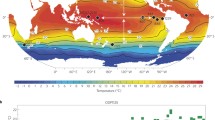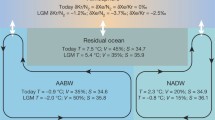Abstract
A dynamical model for the late-Quaternary global variations of δ18O, mean ocean surface tempeature τ, ice mass I, deep ocean temperature θ, and atmospheric carbon dioxide concentration μ, is constructed. This model consists of two diagnostic equations (for δ18O and τ), and three prognostic equations (for I, θ, and μ) of a form studied extensively in previous articles. The carbon dioxide equation includes forcing by a representation of the Milankovitch earth-orbital radiation effects, and contains a basic instability that drives a free oscillation of period near 100,000 years. The system is constrained to conserve mass and energy, contain physically plausible feedbacks including a system time constant no greater than 10.000 years, and be robust (i. e., structurally stable in the presence of expected noise levels and uncertainties in values of coefficients). Within the limits of these constraints, coefficients are chosen such that (i) the solution gives a good fit to the observed SPECMAP δ18O variations, and (ii) the ice mass variations are qualitatively similar to the δ18O variations. The predicted long term variations of sea surface temperature and atmospheric carbon dioxide are in reasonably good agreement with the limited observational evidence available for these quantities, while the predicted variations of deep ocean temperature remain to be verified when paleoclimatic estimates of this quantity become available. The relative contributions of ice mass changes and surface water temperature changes to the variations of δ18O at any time are given by the model.
Similar content being viewed by others
References
Berner W, Oeschger H, Stauffer B (1980) Information on the CO2 cycle from ice core studies. Radiocarbon 22: 227–235
Broecker WS (1982) Ocean chemistry during glacial time. Geochim Cosmochim Acta 46: 1689–1705
Budyko MI (1969) The effect of solar radiation variations on the climate of the earth. Tellus 21: 611–619
Delmas RJ, Ascencio J-M, Legrand M (1980) Polar ice evidence that atmospheric CO2 20,000 yr BP was 50% of present. Nature 284: 155–157
Dodge RE, Fairbanks RG, Benninger LK, Maurrasse F (1983) Pleistocene sea levels from raised coral reefs of Haiti. Science 219: 1423–1425
Ennever FK, McElroy MB (1985) Changes in atmospheric CO2: factors regulating the glacial to interglacial transition. Sundquist ET, Brooker WS, (eds), Geophys Monogr 32, AGU pp 154–162
Eriksson E, Welander P (1956) On a mathematical model of the carbon cycle in nature. Tellus 8: 155–175
Fairbanks RG, Matthews RK (1978) The marine oxygen isotope record in Pleistocene coral, Barbados, West Indies. Quat Res 10: 181–196
Flint RF (1971) Glacial and Quaternary geology. Wiley, New York
Hays JD, Imbrie J, Shackleton NJ (1976) Variations in the earth's orbit: pacemaker of the ice ages. Science: 194: 1121–1132
Hoffert MJ, Callegari AJ, Hsieh C-T (1980) The role of deep sea heat storage in the secular response to climatic forcing. J Geophys Res 85: 6667–6679
Hollin JT (1962) On the glacial history of Antarctica. J Glaciology 4 (32): 173–195
Hughes T (1986) The Jakobshavns effect. Geophys Res Lett: 13: 46–48
Imbrie J, Shackleton NJ, Pisias NG, Morley JJ, Prell WL, Martinson DG, Hays JD, McIntyre A, Mix AC (1984) The orbital theory of pleistocene climate: support from a revised chronology of the marine δ18O record. In: Berger A, Imbrie J, Hays J, Kukla G, Saltzman B (eds) Milankovitch and Climate, Part 1. Reidel, Dordrecht, pp 269–305
Keir RS, Berger WH (1983) Atmospheric CO2 content in the last 120,000 years: the phosphate-extraction model. J Geophys Res 88: 6027–6038
Manabe S, Bryan K Jr (1985) CO2-induced change in a coupled ocean-atmosphere model and its paleoclimatic implications. J Geophys Res 90: 11 689–11 707
Mix AC, Ruddiman WF (1984) Oxygen-isotope analyses and pleistocene ice volumes. Quat Res 21: 1–20
Morley JJ, Shackleton NJ (1984) The effect of accumulation rate on the spectrum of geologic time series: evidence from two South Atlantic sediment cores. In: Berger A, Imbrie J, Hays J, Kukla G, Saltzman B, (eds). Milankovitch and Climate, Part 1. Reidel, Dordrecht, 467–480
Oerlemans J (1980) Model experiments on the 100,000-yr glacial cycle. Nature 287: 430–432
Plass GN (1956) The carbon dioxide theory of climatic change. Tellus 8: 140–154
Prell WL (1984) Monsoonal climate of the Arabian Sea during the Late Quaternary: a response to changing solar radiation. In Berger A, Imbrie J, Hays J, Kukla G, Saltzman B (eds) Milankovitch and Climate Part 1. Reidel, Dordrecht, pp 349–366
Ruddiman WF (1985) Climate studies in ocean cores. In: Paleoclimate analysis and modeling. Hecht AD (ed) Wiley, New York, Chap. 5, 197–257
Saltzman B (1982) Stochastically-driven climatic fluctuations in the sea-ice, ocean temperature, CO2 feedback system. Tellus 34: 97–112
Saltzman B (1983) Climate system analysis. Adv Geophys 25: 173–233
Saltzman B (1984) On the role of equilibrium atmospheric climate models in the theory of long-period glacial variations. J Atmos Sci 41: 2263–2266
Saltzman B (1986) Modeling the δ18O-derived record of Quaternary climatic change with low order dynamical systems. In: Nicolis G (ed) Irreversible Phenomena and Dynamical Systems Analysis in Geosciences, Reidel, (in press)
Saltzman B, Moritz RE (1980) A time-dependent climatic feedback system involving sea-ice extent, ocean temperature, and CO2. Tellus 32: 93–118
Saltzman B, Hansen AR, Maasch KA (1984) The late Quaternary glaciations as the response of a three-component feedback system to earth-orbital forcing. J Atmos Sci 41: 3380–3389
Saltzman B, Sutera A (1984) A model of the internal feedback system involved in late Quaternary climatic variations. J Atmos Sci 41: 736–745
Saltzman B, Sutera A, Evenson A (1981) Structural stochastic stability of a simple auto-oscillatory climatic feedback system. J Atmos Sci 38: 494–503
Shackleton NJ, Opdyke ND (1973) Oxygen isotope and paleomagnetic stratigraphy of equatorial Pacific core V28-238: Oxygen isotope temperature and ice volumes on a 105 and 108 year scale. Quat Res 3: 39–55
Shackleton NJ, Pisias NG (1985) Atmospheric carbon dioxide, orbital forcing, and climate. In: Sundquist ET, Broecker WS (eds) Geophys Monogr 32, AGU, pp 303–317
Toggweiler JR, Sarmiento JL (1985) Glacial to interglacial changes in atmospheric carbon dioxide: the critical role of ocean surface water in high latitudes. In: Sundquist ET, Broecker WS (eds) Geophys Monogr 32, AGU, pp 163–184
US National Academy of Sciences (1982) Carbon Dioxide and Climate: A second assessment. Nat Acad Press, Washington DC
Wenk T, Siegenthaler U (1985) The high latitude ocean as a control of atmospheric CO2. In: Sundquist ET, Broecker WS (eds) Geophys Monogr 32, AGU, pp 185–194
Author information
Authors and Affiliations
Rights and permissions
About this article
Cite this article
Saltzman, B. Carbon dioxide and the δ18O record of late-Quaternary climatic change: a global model. Climate Dynamics 1, 77–85 (1987). https://doi.org/10.1007/BF01054477
Received:
Accepted:
Issue Date:
DOI: https://doi.org/10.1007/BF01054477




